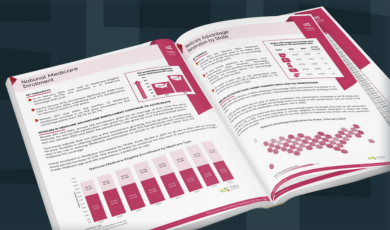BLOG
Stay Top of Mind with Referral Sources During COVID-19: Email Marketing Best Practices
By: Jessica Chew| June 4, 2020
Social distancing is an unfamiliar concept for sales teams who want to stay in touch with current and new referral sources. Fortunately, a well-crafted email campaign can place your home health or hospice organization front and center.
So, how do you structure your email campaign and create content that drives responses? Something to remember is that what works for the one business may not serve another, and to always measure your campaigns success. Email makes it easy to test and fine tune your approach, so here is a rundown of today’s best practices.
Before you Begin, Research your Recipients
Thoroughly researching the customers and prospects on your list is part of an effective sales planning process (and one thing that hasn’t changed with COVID-19). What messages will resonate most with your audiences? What metrics will be most useful or persuasive? What do you want them to do? Call or set an appointment? Click through to a report or blog post? A recommendation from PatientPop is to segment your list as needed for customized content streams.
Structure a Successful Email Campaign
- Leverage a multi-channel, multi-touch approach: for the best results, your email campaign should be part of a larger outreach effort leveraging multiple channels, such as direct mail, phone calls, and social media. The sales and marketing research firm TOPO suggests that for a campaign containing 15 touch points over as many days, roughly 1/3 should be email.
- Set a proven cadence: the rate at which you send your emails is referred to as a “cadence.” SalesLoft, a sales engagement platform, recommends that for the best open rates, you should progressively space emails over the length of the campaign. If your contact has not responded by the end of a 2-3-week campaign, continue to follow-up once or twice a month, but shift your focus to qualifying new high-potential prospects.
- Consider day and time: while current data suggests Monday morning is best for open rates, and Friday afternoon is worst, this is always changing. Test what works for your home health or hospice organization.
- Rapid response is important: once you get a reply, respond as quickly as possible with a personalized email or call. Data shows that responding within an hour is best and will help your business stand out. While this may be difficult under normal circumstances, work-from-home schedules may make this easier to accomplish.
TIP: A suggestion from SalesLoft is to place a call to your current or prospect referral source shortly after you’ve sent your email. If you get their voicemail, let them know that you have sent them something. Ask them to check it out and reply via the email.
Create Content that Generates a Response
Today, emails that get the best response rates are written using a friendly, casual tone. In other words, write the way you would to a colleague or friend.
To keep your referral sources and prospects engaged, serve up a range of content throughout your campaign, all designed to showcase your thought leadership and the advantages of working with you. Trella has created a series of email templates for you to customize and use as thought starters, access them here.
Encourage open rates with strong subject lines: A good subject line will ensure that the hard work you put into your email content pays off. And yet, this may be one of the most challenging practices to follow. Research shows that the best subject lines contain between just one and five words. So how do you accomplish this?
- Be direct. Tell recipients what you’re looking for, such as a meeting or call, or what will they’ll learn, such as how you’re the better organization to partner with.
- That said, words like “better” and other superlatives don’t perform well. Neither do words that suggest the recipient will gain something, such as “increase” or “save.”
- Same goes for putting numbers into your subject lines, so, save them for the body of your email.
- On the flip side, including your company name may help boost your email response rate.
- If you’ve been referred by someone, by all means say so. Referrals can lift open rates 5x or more.
TIP: Data-related words like “findings,” “results,” “research,” and “benchmark” tend to hurt open rates. However, they may drive clicks. So, use them in your subject line when your email asks recipients to click through to a report or blog post.
How you say hello matters: Even the way you address your recipient can have an effect on whether you get a response. Two-word greetings, such as “Hey, Mike,” tend to outperform Mike’s name alone. And the words “Hey” and “Hi” do better than “Dear.”
Focus on one subject at a time: Here are a few ideas to start with:
- Highlight the unique value your home health or hospice agency delivers
- Help recipients understand how increasing utilization can decrease readmissions
- Show how your agencies performance compares to competitors
- Offer tips for keeping the recipient’s patients out of the hospital during COVID-19
- Provide information recipients need to educate their patients and improve compliance
- Demonstrate how your organization can help recipients meet their quality, performance, and cost savings goals
Keep content short: Some experts claim the sweet spot for content length is 50-100 words until you’ve established a relationship with the recipient. However, this leaves precious little space to get your message across. Just remember, in the beginning, less is more.
Personalize 20% of your templated copy: In a short email, you might personalize the first and last sentences of your message. The templates we’ve provided show you where to add customized information. Experts note that beyond 20%, personalization doesn’t buy you much in terms of response rates, so don’t overthink this.
Add an engaging image: A high-quality image or embedded video can really boost engagement, as long as the content is highly relevant to the recipient. If possible, stay away from stock images, which tend to look staged—and may also be used by the agency across town!
Nix the bullets: Data shows that bullets don’t perform well in terms of response rates, especially in the early phases of outreach, this may be because if you need bullets, your email is overly long. Once you’ve established a relationship with a recipient, however, you can send lengthier emails with enough content to warrant bulleted or numbered lists.
Always include a call to action: Tell recipients what you want them to do next. If you’d like them to schedule a meeting, inserting a calendar scheduling app can make the process easier.
Beware of adding hyperlinks: It’s OK to include one link to outside content in your email, but adding more than that may land you in a spam folder. Note that the link to your website used in your email signature counts. Since few people ever click on these signature links, you may want to remove it for your campaign.
How you sign off matters, too: These days, “Best” is scoring higher when it comes to sign-offs. Oddly, “Thank You” isn’t as well received. You’ll also want to stay away from P.S. statements, which were once thought to add value to email marketing. Now, not so much.
Measure. Tweak. Repeat.
As suggested above, email best practices change. People receive thousands of emails each year, and what piques their interest today will eventually feel old. Monitoring your analytics for open rates, click rates, and bounce rates will tell you much about what’s working and what’s not.
If you’re not seeing the results you want, continue to test new options. With a little fine-tuning, your emails can be one of your most valuable tools for staying in front of referral sources and prospects during Covid-19.
About the Author:
 Jessica Chew, VP, Marketing
Jessica Chew, VP, Marketing
With more than 10 years’ experience in healthcare marketing, Jessica not only leads our marketing team but is also a passionate advocate and frequent user of our marketing intelligence solutions.
After graduating from the University of Georgia with a bachelor’s in journalism, Jessica got her start in marketing at Gannett, the largest newspaper publisher in America. She thought this entry-level job was the first step on the road to a career as an investigative reporter — but immediately became hooked on marketing.
At Trella Health, she’s able to do all the things she loved about journalism — digging for information and insights, helping people share their stories — and she’s also able to make a meaningful difference in the way post-acute care is provided.













